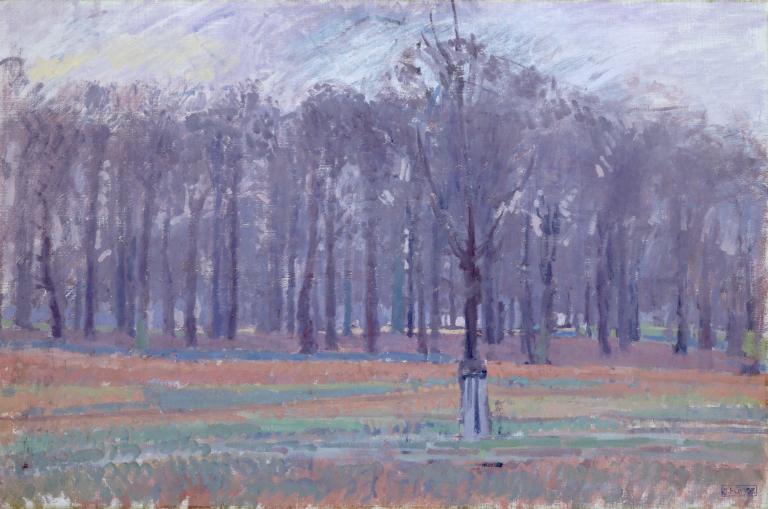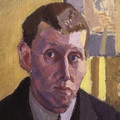Spencer Gore Richmond Park c.1914
Spencer Gore,
Richmond Park
c.1914
The solitary tree in the middle ground of this painting is protected by a guard against the deer living in Richmond Park. Behind it, a rhythmic row of darkly austere trees spreads across the horizon of the canvas, forming a dense copse blurry with mist. This was a remarkable departure from Gore’s geometric treatment of the landscape at Letchworth Garden City. Gore lived near the Cambrian Gate entrance to Richmond Park, a setting which fascinated him, featuring in a series of twenty-five canvases executed over a few months.
Spencer Gore 1878–1914
Richmond Park
c.1914
Oil paint on canvas
510 x 760 mm
Inscribed by ?Harold Gilman ‘S.F. Gore in 1914: | Park, unsigned. | (206)’ on label fragment on back; studio stamp ‘S.F. GORE’ bottom right.
Bequeathed by Lady Henry Cavendish-Bentinck 1940
N05100
c.1914
Oil paint on canvas
510 x 760 mm
Inscribed by ?Harold Gilman ‘S.F. Gore in 1914: | Park, unsigned. | (206)’ on label fragment on back; studio stamp ‘S.F. GORE’ bottom right.
Bequeathed by Lady Henry Cavendish-Bentinck 1940
N05100
Ownership history
Mrs Mary Johanna Gore, the artist’s widow; bought Paterson and Carfax Gallery, London, 1920 by Lord Henry Cavendish-Bentinck (1863–1931) for £94.10s; his widow, Lady Olivier Cavendish-Bentinck bequeathed to Tate Gallery 1940.
Exhibition history
1914
?Fifty First Exhibition of Modern Pictures by the New English Art Club, Galleries of the Royal Society of British Artists, London, Summer 1914 (181, as ‘Richmond Park trees’).
1920
Paintings by the Late Spencer F. Gore, Paterson and Carfax Gallery, London, October 1920 (1, as ‘Richmond Park No.1’).
1928
Exhibition of Paintings by Spencer F. Gore, Leicester Galleries, London, April 1928 (65).
1939
An Exhibition of Contemporary British Art, (British Council tour), Instytut Propogandy Sztuki, Warsaw, January–February 1939, Taidehalli-Konsthallen, Helsingfors, March 1939, Liljevalchs Konsthall, Stockholm, April–May 1939 (26, as ‘Group of Trees’).
1942
The Tate Gallery’s Wartime Acquisitions, National Gallery, London, April–May 1942 (40).
1942–3
A Selection from the Tate Gallery’s Wartime Acquisitions, (Council for the Encouragement of Music and the Arts tour), Royal Exchange, London, July–August 1942, Cheltenham Art Gallery, September 1942, Ashmolean Museum, Oxford, October 1942, Galleries of Birmingham Society of Arts, November–December 1942, Fitzwilliam Museum, Cambridge, January–February 1943, Victoria Art Gallery, Bath, February–March 1943, National Museum of Wales, Cardiff, March–April 1943, Manchester City Art Gallery, April–May 1943, Philharmonic Hall, Liverpool, May–June 1943, National Gallery of Scotland, Edinburgh, June 1943, Glasgow Museum and Art Gallery, Kelvingrove, July 1943, Laing Art Gallery, Newcastle upon Tyne, August 1943 (21).
1946–7
Modern British Pictures from the Tate Gallery, (British Council tour), Palais des Beaux-Arts, Brussels, January–February 1946 (17), Stedelijk Museum, Amsterdam, March 1946 (17), Raadhushallen, Copenhagen, April–May 1946 (17), Musée du Jeu de Paume, Paris, June–July 1946 (17), Musée des Beaux-Arts, Berne, August 1946 (16), Akademie Der Bildenden Künste, Vienna, September 1946 (16), Narodni Galerie, Prague, October–November 1946 (16), Muzeum Narodowe, Warsaw, November–December 1946 (16), Galleria d’Arte Moderna, Rome, January–February 1947 (16).
1947
Tate Gallery 1897–1947: Pictures from the Tate Gallery Foundation and Exhibition of Subsequent British Painting, Tate Gallery, London, May–September 1947 (5100).
1947–8
Modern British Pictures from the Tate Gallery, (Arts Council tour), Leicester Museum and Art Gallery, September–October 1947, Graves Art Gallery, Sheffield, October–November 1947, Birmingham City Museum and Art Gallery, November–December 1947, Bristol City Art Gallery, January–February 1948, Russell-Cotes Art Gallery, Bournemouth, February–March 1948, Brighton Art Gallery and Museum, March–April 1948, Plymouth Art Gallery, April–May 1948, Castle Museum, Nottingham, May–June 1948, Huddersfield Museum and Art Gallery, June–July 1948, Aberdeen Art Gallery, July–August 1948, Salford Art Gallery and Museum, August–September 1948 (9).
1951
Edwardian Exhibition, Towner Art Gallery, Eastbourne, July–September 1951 (88).
1960–5
Hatton Gallery, Newcastle upon Tyne 1960–5 (long loan).
1989–92
Government Art Collection, 10 Downing Street, September 1989–July 1992 (long loan).
1995–6
Government Art Collection, September 1995–July 1996 (long loan).
1996–7
Spencer Gore in Richmond, Museum of Richmond, September 1996–January 1997 (no number, reproduced p.39).
2008
Modern Painters: The Camden Town Group, Tate Britain, London, February–May 2008 (88, reproduced).
References
1964
Mary Chamot, Dennis Farr and Martin Butlin, Tate Gallery Catalogues: The Modern British Paintings, Drawings and Sculpture, vol.1, London 1964, p.247.
1979
Wendy Baron, The Camden Town Group, London 1979, p.375.
2000
Wendy Baron, Perfect Moderns: A History of the Camden Town Group, Aldershot and Vermont 2000, p.182.
Technique and condition
Richmond Park is painted in artists’ oil paints on primed stretched canvas. The support is stretched onto a four-member stretcher and retains its original attachment with tacks. A fragment of a paper label, which appears to be in Harold Gilman’s hand, is adhered to the back (see also Tate T02260). It bears the partial inscription: ‘S.F. Gore in 1914: | Park, unsigned. | (206)’. The canvas appears to be linen and has a relatively fine weave in comparison to Gore’s other works. The canvas was prepared and supplied pre-stretched by George Rowney & Co and it is the same type of ‘Quality B’ canvas used for From a Window in Cambrian Road, Richmond (see Tate N03558). The cloth has been prepared with glue size, which formed a thick layer when applied. There is a dense white primer, which was evenly applied and retains the canvas weave texture. The preparatory surface seems quite lean and as such would have provided a slightly absorbent ‘ground’ for painting.
The outline of the composition was freely sketched in thinned blue paint and subsequently modified during painting (see also Tate T02260). The picture is loosely built up using opaque mixtures of oil paint, which have dried to a slightly matt finish. Colours are applied in dabs, broken strokes and scumbles that retain vigorous brushmarking. Several modifications were made during painting, for example to the height and the position of the tree in the foreground and to the height of the copse of trees behind. These were reworked by overlaying the paint used to colour the sky, obliterating the underlying layers and moving the point at which the trees appear to intersect the sky. Traces of the earlier position of the tree can be glimpsed through the overlying layers of paint but this is probably because the paint has become more transparent over time. ‘Pentimenti’ and other underlying stages in the painting, are deliberately left visible at the surface, where the overlying fluid paint has conformed to the texture of underlying painted shapes, forming ridges. Final touches reinstate glimmers of sky in between the forms of the trees, defining the point at which they meet. The surface is unvarnished retaining the relatively matt aesthetic of the painting.
Roy Perry and Sarah Morgan
July 2005
How to cite
Roy Perry and Sarah Morgan, 'Technique and Condition', July 2005, in Robert Upstone, ‘Richmond Park c.1914 by Spencer Gore’, catalogue entry, May 2009, in Helena Bonett, Ysanne Holt, Jennifer Mundy (eds.), The Camden Town Group in Context, Tate Research Publication, May 2012, https://wwwEntry
Richmond Park was just a short distance from Gore’s home at 6 Cambrian Road, the Cambrian Gate entrance being about a hundred yards away. The park must have exerted a strong fascination as it formed the subject of around twenty-five canvases, made in just a few months.1 In this remarkable series of works he retreated from the hard-edged geometry that characterises the pictures he had made in Letchworth Garden City in 1912 and to a certain degree some of those made early in Richmond. Gore rediscovered the poetry and lyricism of pure landscape that had been a characteristic of his earlier work. Yet the Richmond Park series also mark another stride in the artist’s development and ever evolving vision. The loose patches of colour in many of these pictures demonstrate that while he had thoroughly absorbed the style of Paul Cézanne, he had also gone further to find his own unique mode of expression. As a series, rather like all Gore’s work, they possess a spirit of constant transition, each new canvas refining and revising the style and execution of the one before. Although restricted in their subject matter, or perhaps because of it, these pictures display a new breadth and firmness of structure, as well as a remarkable sensitivity and delicacy. Their colour range and harmony is particularly noticeable.
But Gore’s hard work in Richmond Park and great devotion to this series was to lead to his destruction. He followed a regime of painting outdoors, directly before the subject, and in March 1914 he got wet and contracted pneumonia. Within just a few days he was dead.
The Tate picture is among the larger Richmond Park canvases Gore made. It is an austere composition of a row of trees, stretching regularly across the canvas in a band. But Gore lends the scene rhythm and interest by subtle modulations of the paint, applying it in a series of dabs, the warmth of the russet tones contrasting with the cooler, darker colours of the trees and the sky above. This is a winter scene, the bracken now brown, and perhaps the suggestion of a slight mist among the trees. The solitary tree that stands nearer has a guard around it to stop damage from the deer native to the park. Establishing the location of the scene is difficult as the trees in Richmond Park have changed in the intervening period. But a row of trees close to the pond near Cambrian Gate have a very close resemblance and would fit Gore’s usual practice of painting scenes close to home.
Robert Upstone
May 2009
Notes
Related biographies
Related essays
- Canvas and its Preparation in Early Twentieth-Century British Paintings Sarah Morgan, Joyce H. Townsend, Stephen Hackney and Roy Perry
- The Camden Town Group and Early Twentieth-Century Ruralism Ysanne Holt
Related catalogue entries
Related reviews and articles
- Wyndham Lewis, ‘Frederick Spencer Gore’ BLAST, No.1, June 1914, p.150.
- Walter Richard Sickert, ‘A Perfect Modern’ The New Age, 9 April 1914, p.718.
How to cite
Robert Upstone, ‘Richmond Park c.1914 by Spencer Gore’, catalogue entry, May 2009, in Helena Bonett, Ysanne Holt, Jennifer Mundy (eds.), The Camden Town Group in Context, Tate Research Publication, May 2012, https://www



